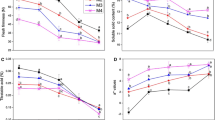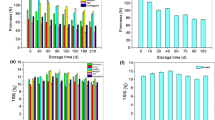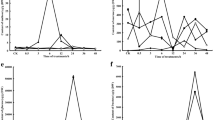Abstract
To investigate soluble sugar metabolism and its relationship to chilling injury (CI), loquat fruits were stored at 0 and 5 °C for 5 weeks. CI symptoms were monitored during storage, and soluble sugar content and related enzyme activities were measured. Enzymes activities and substrate levels in the ascorbate–glutathione (AsA-GSH) cycle were also determined. Fruit at 0 °C had lower sucrose levels and higher levels of glucose and fructose than fruit maintained at 5 °C, and also manifested less severe CI symptoms. Fruit at 0 °C also exhibited increased activities of acid invertase, neutral invertase, sucrose phosphatesynthase and sucrose synthase. AsA-GSH cycle activity at 0 °C was much higher than that at 5 °C. Glucose levels correlated positively with levels of AsA and GSH and ascorbate peroxidase (APX) activity. The increased glucose levels are sufficient to account for the chilling tolerance of loquat fruit.






Similar content being viewed by others
References
Abidi W, Cantín CM, Jiménez S, Giménez R, Moreno MÁ, Gogorcena Y (2015) Influence of antioxidant compounds, total sugars and genetic background on the chilling injury susceptibility of a non-melting peach (Prunus persica (L.) Batsch) progeny. J Sci Food Agric 95:351–358
Cai C, Xu CJ, Li X, Ferguson I, Chen KS (2006) Accumulation of lignin in relation to change in activities of lignification enzymes in loquat fruit flesh after harvest. Postharvest Biol Technol 40:163–169
Cai Y, Cao S, Yang Z, Zheng Y (2011) MeJA regulates enzymes involved in ascorbic acid and glutathione metabolism and improves chilling tolerance in loquat fruit. Postharvest Biol Technol 59:324–326
Cai X, Wang H, Pang G (2015) Flux control analysis of a lactate and sucrose metabolic network at different storage temperatures for Hami melon (Cucumis melo var. saccharinus). Sci Hortic 181:4–12
Cao S, Zheng Y, Wang K, Jin P, Rui H (2009a) Methyl jasmonate reduces chilling injury and enhances antioxidant enzyme activity in postharvest loquat fruit. Food Chem 115:1458–1463
Cao S, Zheng Y, Wang K, Rui H, Tang S (2009b) Effect of 1-methylcyclopropene treatment on chilling injury, fatty acid and cell wall polysaccharide composition in loquat fruit. J Agric Food Chem 57:8439–8443
Cao S, Zheng Y, Wang K, Rui H, Tang S (2010) Effect of methyl jasmonate on cell wall modification of loquat fruit in relation to chilling injury after harvest. Food Chem 118:641–647
Cao S, Yang Z, Cai Y, Zheng Y (2011) Fatty acid composition and antioxidant system in relation to susceptibility of loquat fruit to chilling injury. Food Chem 127:1777–1783
Cao S, Yang Z, Zheng Y (2013) Sugar metabolism in relation to chilling tolerance of loquat fruit. Food Chem 136:139–143
Couée I, Sulmon C, Gouesbet G, Amrani AE (2006) Involvement of soluble sugars in reactive oxygen species balance and responses to oxidative stress in plants. J Exp Bot 57:449–459
Ding C, Chachin K, Ueda Y, Imahori Y, Wang CY (2002) Modified atmosphere packaging maintains postharvest quality of loquat fruit. Postharvest Biol Technol 24:341–348
Hodges DM, Lester GE, Munro KD, Toivonen PMA (2004) Oxidative stress: importance for postharvest quality. HortScience 39:924–929
Holland N, Menezes HC, Lafuente MT (2002) Carbohydrates as related to the heat-induced chilling tolerance and respiratory rate of ‘Fortune’ mandarin fruit harvested at different maturity stages. Postharvest Biol Technol 25:181–191
Itai A, Tanahashi T (2008) Inhibition of sucrose loss during cold storage in Japanese pear (Pyrus pyrifolia Nakai) by 1-MCP. Postharvest Biol Technol 48:355–363
Jin P, Zhang Y, Shan T, Huang Y, Xu J, Zheng Y (2015) Low-temperature conditioning alleviates chilling injury in loquat fruit and regulates glycine betaine content and energy status. J Agri Food Chem 63:3654–3659
Keunen E, Peshev D, Vangronsveld J (2013) Plant sugars are crucial players in the oxidative challenge during abiotic stress: extending the traditional concept. Plant Cell Environ 36:1242–1255
Ma Y, Zhang Y, Lu J, Shao H (2009) Roles of plant soluble sugars and their responses to plant cold stress. Afr J Biotechnol 8:2004–2010
Miller GL (1959) Use of dinitro salicylic acid reagent for determination of reducing sugar. Anal Chem 31:426–428
Nishikawa F, Kato M, Hyodo H, Ikoma Y, Sugiura M, Yano M (2003) Ascorbate metabolism in harvested broccoli. J Exp Bot 54:2439–2448
Nishikawa F, Kato M, Hyodo H, Ikoma Y, Sugiura M, Masamichi Y (2005) Effect of sucrose on ascorbate level and expression of genes involved in the ascorbate biosynthesis and recycling pathway in harvested broccoli florets. J Exp Bot 56:65–72
Noctor G, Foyer C (1998) Ascorbate and glutathione: keeping active oxygen species under control. Annu Rev Plant Physiol Mol Biol 49:249–279
Ogawa A, Fujita S, Toyofuku K (2014) A cultivation method for lettuce and spinach with high levels of vitamin C using potassium restriction. Environ Control Biol 52:95–99
Palma F, Carvajal F, Lluch C, Jamilena M, Garrido D (2014) Changes in carbohydrate content in zucchini fruit (Cucurbita pepo L.) under low temperature stress. Plant Sci 217:78–86
Quan L, Zhang B, Shi W, Li H (2008) Hydrogen peroxide in plants: a versatile molecule of the reactive oxygen species network. J Integr Plant Biol 50:2–18
Ruelland E, Vaultier MN, Zachowski A, Hurry V (2009) Cold signaling and cold acclimation in plants. Adv Bot Res 49:35–150
Rui H, Cao S, Shang H, Jin P, Wang K, Zheng Y (2010) Effects of heat treatment on internal browning and membrane fatty acid in loquat fruit in response to chilling stress. J Sci Food Agr 90:1557–1561
Shao X, Tu K, Tu S, Tu J (2012) A combination of heat treatment and chitosan coating delays ripening and reduces decay in ‘Gala’ apple fruit. J Food Qual 35:83–92
Shao X, Zhu Y, Cao S, Wang H, Song Y (2013) Soluble sugar content and metabolism as related to the heat-induced chilling tolerance of loquat fruit during cold storage. Food Bioprocess Technol 6:3490–3498
Smirnoff N, Conklin PL, Loewus FA (2001) Biosynthesis of ascorbic acid in plants: a renaissance. Annu Rev Plant Biol 52:437–467
van den Ende W, Valluru R (2009) Sucrose, sucrosyl oligosaccharides, and oxidative stress: scavenging and salvaging? J Exp Bot 60:9–18
van Handel E (1963) Direct microdetermination of sucrose. Anal Biochem 22:280–283
Wang K, Shao X, Gong Y, Zhu Y, Wang H, Zhang X, Yu D, Yu F, Qiu Z, Lu H (2013) The metabolism of soluble carbohydrates related to chilling injury in peach fruit exposed to cold stress. Postharvest Biol Technol 86:53–61
Wang K, Shao X, Gong Y, Xu F, Wang H (2014) Effects of postharvest hot air treatment on gene expression associated with ascorbic acid metabolism in peach fruit. Plant Mol Biol Report 32:881–887
Wang Z, Cao J, Jiang W (2016) Changes in sugar metabolism caused by exogenous oxalic acid related to chilling tolerance of apricot fruit. Postharvest Biol Technol 114:10–16
Xu H, Chen J, Xie M (2010) Effect of different light transmittance paper bags on fruit quality and antioxidant capacity in loquat. J Sci Food Agric 90:1783–1788
Zhang B, Xi W, Wei W, Shen J, Ferguson I, Chen K (2011) Changes in aroma-related volatiles and gene expression during low temperature storage and subsequent shelf-life of peach fruit. Postharvest Biol Technol 60:7–16
Acknowledgements
This study was sponsored by the National Science Foundation of China (No. 31671903), the Nature Science Foundation of Zhejiang Province (No. LR15C200002), and the K. C. Wong Magna Fund in Ningbo University.
Author information
Authors and Affiliations
Corresponding author
Ethics declarations
Conflict of interest
No potential conflict of interest was reported by the authors.
Rights and permissions
About this article
Cite this article
Wei, Y., Xu, F. & Shao, X. Changes in soluble sugar metabolism in loquat fruit during different cold storage. J Food Sci Technol 54, 1043–1051 (2017). https://doi.org/10.1007/s13197-017-2536-5
Revised:
Accepted:
Published:
Issue Date:
DOI: https://doi.org/10.1007/s13197-017-2536-5




